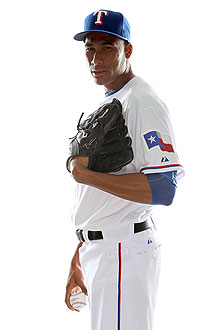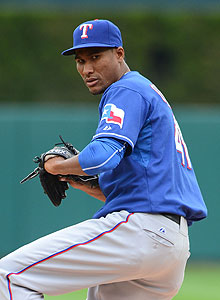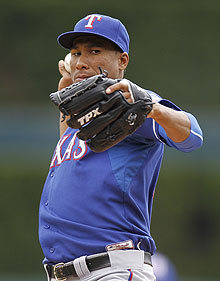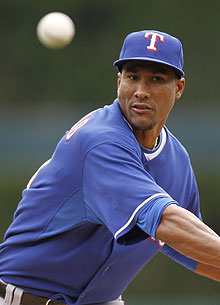http://t.co/quVuzxN
Alexi Ogando(notes) barely met the woman who cost him five years of his life. He didn’t get her name. Wouldn’t recognize her face. She still doesn’t seem real.
She haunted him. Ogando, one of the best pitchers in baseball this season, spent half a decade isolated from the world that was supposed to be his because of her. His jail cell was the 19,000-square-mile island on which he lived his whole life, the Dominican Republic, and he wasn’t allowed to decamp to America. Only a handful of men in the world threw a baseball harder than Ogando. The Texas Rangers cherished his right arm. No matter what the team did, it couldn’t get him past the border.

Alexi Ogando is trying to put his tumultuous days in the Dominican Republic behind him.
(Getty Images)
(Getty Images)
For participating, Ogando was supposed to receive $3,000. The money never came. The consequences did. When Ogando applied for a U.S. work visa in early 2005, the State Department denied him. Same the next year. And the year after that. And the following year. Ogando pleaded ignorance from the start. The excuse wasn’t compelling enough to open the border.
“I trusted in God,” Ogando said. “I had to. There wasn’t anything else to trust in.”
Until another woman came along. She gave him her name. He learned her face. She was undeniably real.
And before his career vanished, she saved him.
“I think I can get him off,” Charisse Espinosa-Dash said, and she wasn’t the first to say so. It was February 2009. She was visiting Eladio Moronta, a New York Yankees prospect she represents, and ran into a group of Rangers executives at the team’s complex in the Dominican Republic. They talked about the cases of Ogando and Omar Beltre(notes), another hard-throwing right-hander, and how Espinosa-Dash believed she could do what the president of the United States couldn’t.
For all the appeals the Rangers had lodged to free Ogando and Beltre, the greatest went to the Oval Office, occupied by former Rangers owner George W. Bush. It didn’t lift the ban. Neither did working with Immigration and Customs Enforcement, the Department of Homeland Security, a handful of immigration attorneys, the U.S. Consulate in the D.R. and intervention from Major League Baseball and the MLB Players Association.
Their arguments that Ogando and Beltre were among the victims, too – led into the scheme by a man known as Wilson who ran in Dominican baseball circles – never resonated. Rejection beget dejection.
“These were kids who didn’t know the repercussions of violating a visa,” Espinosa-Dash said. “They don’t know fraud. They were just as vulnerable as the ladies being trafficked.”
Espinosa-Dash, one of a handful of female player agents, suggested another antidote: win the bureaucrats’ hearts instead of their minds.

Argenis Benitez, a.k.a. Alexi Ogando, originally signed with the A’s for $15,000.
(Getty Images)
(Getty Images)
So by the time the A’s discovered in 2003 that Argenis Benitez’s real name was Alexi Ogando – and his real age was 20, not 19 – they were more or less done with him. The marriage snafu after the 2004 season cemented it. They left him exposed in the minor league portion of the Rule 5 draft, where A.J. Preller, the Rangers’ crafty head of scouting, suggested the team scoop up Ogando. There was one catch: Preller wanted to convert him to a pitcher.
The Rangers spent $12,500 on the pick, and in Ogando’s first bullpen session, he lit up the radar gun in the high 90s. While the Rangers tried to figure out Ogando’s legal predicament, he figured out how to throw a slider and changeup in addition to the electric fastball.
“I’ve been going down there since I got this job,” said Rangers manager Ron Washington. “I’d see him and just dream. He was darting the strike zone then. He was facing babies.”
Surrounded by just-signed teenagers, Ogando overwhelmed hitters as a relief pitcher for the Rangers’ Dominican Summer League team. Back he went, summer after summer, dominating just the same, watching kids he embarrassed graduate to organized baseball in the United States while he waited for something he was certain never would come.
“A.J. and the other guys would come back from the Dominican, saying ‘We’ve got to get these guys in the States – they’re big league players. We’ve got to find a way to make this work,’ ” said Rangers general manager Jon Daniels. “I don’t want to pretend like we did it all for altruistic reasons. But we’d go down there and talk to these guys and try to help them deal with this.
“I remember one experience where Omar, [assistant GM Thad Levine] and I are standing in our parking lot at the complex, and Omar broke down. We were encouraging him to keep fighting. We weren’t going to forget about him. It was tough: He was stuck.”
To unstick Ogando and Beltre, Charisse Espinosa-Dash used her law-school smarts and the power of a lobbying firm to mock up the idea that sprung them from the D.R. Nothing spoke to the government like advocacy and activism, and she vowed to turn the ballplayers into loud voices against human trafficking.

Frustrated by his lengthy wait for the States, Ogando flew to Japan to gauge interest.
(Getty Images)
(Getty Images)
It wasn’t certain to work.
“Even though what they had done by your standards or mine wasn’t the same as an enemy of the country or a terrorist,” Daniels said, “they were banished like it.”
Frustrated by the wait and desperate to earn more than the pittance paid during their five seasons in the DSL, Ogando and Beltre flew with Preller to Japan to gauge interest in playing there. Though both thrived during workouts, they agreed to give the Rangers one more season to solve the problem.
Espinosa-Dash’s solution seemed to be working. She kept in close contact with Levine, and he apprised Daniels of the progress. Ten months after Espinosa-Dash started working back channels, Ogando and Beltre received their visa appointments. Soon thereafter, they were finally approved.
Just to make sure, Rangers director of international operations Mike Daly flew down to the D.R. to escort them through Immigration before spring training in February 2010. Daniels knew the exact moment they arrived. Daly sent him a picture on his phone of Ogando and Beltre smiling. Each was holding a stamped passport.
“I’m lucky to be here,” Alexi Ogando said, and he’s right: inside a real major league clubhouse, making a real major league salary, living a real major league life. “I was a kid; I did something wrong. A lot of people can’t recover.”
Ogando’s ascent to the top of baseball’s fiefdom happened in fast forward. During spring training, he took a crash course on pitching from Mike Maddux and Andy Hawkins: when to throw a ball in the dirt, when to expand the strike zone, when to go up and in, when to move a runner off the plate.
The Rangers started him at Double-A, moved him to Triple-A and summoned him in the middle of last June. Ogando won the first three games in which he pitched, didn’t give up a run for more than three weeks and finished the season with a 1.30 ERA in more than 40 innings.

Finally in the majors, Ogando gladly made the transition from reliever to starter. His first 10 starts produced a league-leading 0.91 WHIP.
(Getty Images)
(Getty Images)
Which is why the discussion came up in the Rangers’ front office this offseason to make Ogando a starter. He did it three times at Double-A – that’s it. The Rangers cooled on the idea at first but used it as Plan D after a rash of injuries to pitchers forced them to look internally and choose the likeliest to succeed.
This was nothing. Ogando wanted to start – the challenge, the rush, the ability to throw more and use the arm that lay dormant for so long. He is already 27. He sits quietly in the Rangers’ clubhouse and spends time thinking. “He don’t say much,” Washington said. “He walks around looking like he’s stupid. But he’s not.”
Just contemplative. Mature. Grown. He’s 5-0 this year with a 2.33 ERA. No American League pitcher has allowed fewer walks and hits per inning. Opponents are batting .191 against him. Ogando’s fastball, clocked as the fourth-hardest from a starter, looks even faster, according to hitters, because of his funky delivery. It’s the antithesis of smooth mechanics, with his whip-quick arm hiding the ball behind his hip and his follow-through capped off by a leg-whirling flourish.
He perfected that motion in the Dominican Republic, a place where hazy memories still exist. Ogando wants to bury them, and with each good start he comes closer to forgetting. “I’ve just got to let it go,” he said. “That whole world is gone. I’m here now. I’m doing this. I don’t bother looking back. I can’t. I’m not sure what my future is.
“I just know that every time I go to the mound, I decide it.”
Not her. Not anymore.

No comments:
Post a Comment